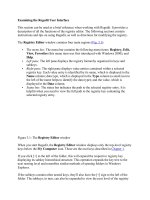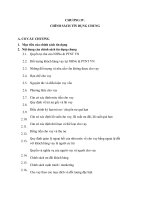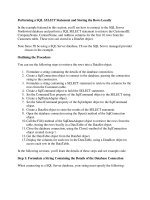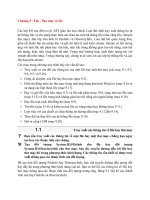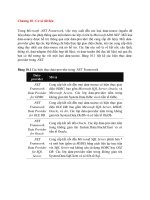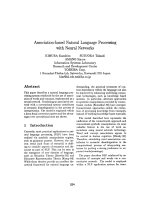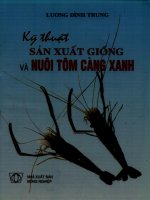Natural Language Processing with Python Phần 1 docx
Bạn đang xem bản rút gọn của tài liệu. Xem và tải ngay bản đầy đủ của tài liệu tại đây (1.18 MB, 51 trang )
Natural Language Processing with Python
Natural Language Processing
with Python
Steven Bird, Ewan Klein, and Edward Loper
Beijing
•
Cambridge
•
Farnham
•
Köln
•
Sebastopol
•
Taipei
•
Tokyo
Natural Language Processing with Python
by Steven Bird, Ewan Klein, and Edward Loper
Copyright © 2009 Steven Bird, Ewan Klein, and Edward Loper. All rights reserved.
Printed in the United States of America.
Published by O’Reilly Media, Inc., 1005 Gravenstein Highway North, Sebastopol, CA 95472.
O’Reilly
books
may be purchased for educational, business, or sales promotional use. Online editions
are also available for most titles (). For more information, contact our
corporate/institutional sales department: (800) 998-9938 or
Editor: Julie Steele
Production Editor: Loranah Dimant
Copyeditor: Genevieve d’Entremont
Proofreader: Loranah Dimant
Indexer: Ellen Troutman Zaig
Cover Designer: Karen Montgomery
Interior Designer: David Futato
Illustrator: Robert Romano
Printing History:
June 2009:
First Edition.
Nutshell
Handbook, the Nutshell Handbook logo, and the O’Reilly logo are registered trademarks of
O’Reilly Media,
Inc. Natural Language Processing with Python, the image of a right whale, and related
trade dress are trademarks of O’Reilly Media, Inc.
Many of the designations used by manufacturers and sellers to distinguish their products are claimed as
trademarks. Where those designations appear in this book, and O’Reilly Media, Inc. was aware of a
trademark claim, the designations have been printed in caps or initial caps.
While every precaution has been taken in the preparation of this book, the publisher and authors assume
no responsibility for errors or omissions, or for damages resulting from the use of the information con-
tained herein.
ISBN: 978-0-596-51649-9
[M]
1244726609
Table of Contents
Preface . . . . . . . . . . . . . . . . . . . . . . . . . . . . . . . . . . . . . . . . . . . . . . . . . . . . . . . . . . . . . . . . . . . . . ix
1. Language Processing and Python . . . . . . . . . . . . . . . . . . . . . . . . . . . . . . . . . . . . . . . . . . 1
1.1 Computing with Language: Texts and Words 1
1.2 A Closer Look at Python: Texts as Lists of Words 10
1.3 Computing with Language: Simple Statistics 16
1.4 Back to Python: Making Decisions and Taking Control 22
1.5 Automatic Natural Language Understanding 27
1.6 Summary 33
1.7 Further Reading 34
1.8 Exercises 35
2. Accessing Text Corpora and Lexical Resources . . . . . . . . . . . . . . . . . . . . . . . . . . . . . . . 39
2.1 Accessing Text Corpora 39
2.2 Conditional Frequency Distributions 52
2.3 More Python: Reusing Code 56
2.4 Lexical Resources 59
2.5 WordNet 67
2.6 Summary 73
2.7 Further Reading 73
2.8 Exercises 74
3. Processing Raw Text . . . . . . . . . . . . . . . . . . . . . . . . . . . . . . . . . . . . . . . . . . . . . . . . . . . . 79
3.1 Accessing Text from the Web and from Disk 80
3.2 Strings: Text Processing at the Lowest Level 87
3.3 Text Processing with Unicode 93
3.4 Regular Expressions for Detecting Word Patterns 97
3.5 Useful Applications of Regular Expressions 102
3.6 Normalizing Text 107
3.7 Regular Expressions for Tokenizing Text 109
3.8 Segmentation 112
3.9 Formatting: From Lists to Strings 116
v
3.10 Summary 121
3.11 Further Reading 122
3.12 Exercises 123
4. Writing Structured Programs . . . . . . . . . . . . . . . . . . . . . . . . . . . . . . . . . . . . . . . . . . . 129
4.1 Back to the Basics 130
4.2 Sequences 133
4.3 Questions of Style 138
4.4 Functions: The Foundation of Structured Programming 142
4.5 Doing More with Functions 149
4.6 Program Development 154
4.7 Algorithm Design 160
4.8 A Sample of Python Libraries 167
4.9 Summary 172
4.10 Further Reading 173
4.11 Exercises 173
5. Categorizing and Tagging Words . .
. . . . . . . . . . . . . . . . . . . . . . . . . . . . . . . . . . . . . . 179
5.1 Using a Tagger 179
5.2 Tagged Corpora 181
5.3 Mapping Words to Properties Using Python Dictionaries 189
5.4 Automatic Tagging 198
5.5 N-Gram Tagging 202
5.6 Transformation-Based Tagging 208
5.7 How to Determine the Category of a Word 210
5.8 Summary 213
5.9 Further Reading 214
5.10 Exercises 215
6. Learning to Classify Text . .
. . . . . . . . . . . . . . . . . . . . . . . . . . . . . . . . . . . . . . . . . . . . . 221
6.1 Supervised Classification 221
6.2 Further Examples of Supervised Classification 233
6.3 Evaluation 237
6.4 Decision Trees 242
6.5 Naive Bayes Classifiers 245
6.6 Maximum Entropy Classifiers 250
6.7 Modeling Linguistic Patterns 254
6.8 Summary 256
6.9 Further Reading 256
6.10 Exercises 257
7. Extracting Information from Text . .
. . . . . . . . . . . . . . . . . . . . . . . . . . . . . . . . . . . . . . 261
7.1 Information Extraction 261
vi | Table of Contents
7.2 Chunking 264
7.3 Developing and Evaluating Chunkers 270
7.4 Recursion in Linguistic Structure 277
7.5 Named Entity Recognition 281
7.6 Relation Extraction 284
7.7 Summary 285
7.8 Further Reading 286
7.9 Exercises 286
8. Analyzing Sentence Structure . . . . . . . . . . . . . . . . . . . . . . . . . . . . . . . . . . . . . . . . . . . 291
8.1 Some Grammatical Dilemmas 292
8.2 What’s the Use of Syntax? 295
8.3 Context-Free Grammar 298
8.4 Parsing with Context-Free Grammar 302
8.5 Dependencies and Dependency Grammar 310
8.6 Grammar Development 315
8.7 Summary 321
8.8 Further Reading 322
8.9 Exercises 322
9. Building Feature-Based Grammars . . . . . . . . . . . . . . . . . . . . . . . . . . . . . . . . . . . . . . 327
9.1 Grammatical Features 327
9.2 Processing Feature Structures 337
9.3 Extending a Feature-Based Grammar 344
9.4 Summary 356
9.5 Further Reading 357
9.6 Exercises 358
10. Analyzing the Meaning of Sentences . . . . . . . . . . . . . . . . . . . . . . . . . . . . . . . . . . . . . 361
10.1 Natural Language Understanding 361
10.2 Propositional Logic 368
10.3 First-Order Logic 372
10.4 The Semantics of English Sentences 385
10.5 Discourse Semantics 397
10.6 Summary 402
10.7 Further Reading 403
10.8 Exercises 404
11. Managing Linguistic Data . .
. . . . . . . . . . . . . . . . . . . . . . . . . . . . . . . . . . . . . . . . . . . . 407
11.1 Corpus Structure: A Case Study 407
11.2 The Life Cycle of a Corpus 412
11.3 Acquiring Data 416
11.4 Working with XML 425
Table of Contents | vii
11.5 Working with Toolbox Data 431
11.6 Describing Language Resources Using OLAC Metadata 435
11.7 Summary 437
11.8 Further Reading 437
11.9 Exercises 438
Afterword: The Language Challenge . . . . . . . . . . . . . . . . . . . . . . . . . . . . . . . . . . . . . . . . . . . 441
Bibliography . . . . . . . . . . . . . . . . . . . . . . . . . . . . . . . . . . . . . . . . . . . . . . . . . . . . . . . . . . . . . . . 449
NLTK Index . . . . . . . . . . . . . . . . . . . . . . . . . . . . . . . . . . . . . . . . . . . . . . . . . . . . . . . . . . . . . . . . 459
General Index . . . . . . . . . . . . . . . . . . . . . . . . . . . . . . . . . . . . . . . . . . . . . . . . . . . . . . . . . . . . . . 463
viii | Table of Contents
Preface
This is a book about Natural Language Processing. By “natural language” we mean a
language that is used for everyday communication by humans; languages such as Eng-
lish, Hindi, or Portuguese. In contrast to artificial languages such as programming lan-
guages and mathematical notations, natural languages have evolved as they pass from
generation to generation, and are hard to pin down with explicit rules. We will take
Natural Language Processing—or NLP for short—in a wide sense to cover any kind of
computer manipulation of natural language. At one extreme, it could be as simple as
counting word frequencies to compare different writing styles. At the other extreme,
NLP involves “understanding” complete human utterances, at least to the extent of
being able to give useful responses to them.
Technologies based on NLP are becoming increasingly widespread. For example,
phones and handheld computers support predictive text and handwriting recognition;
web search engines give access to information locked up in unstructured text; machine
translation allows us to retrieve texts written in Chinese and read them in Spanish. By
providing more natural human-machine interfaces, and more sophisticated access to
stored information, language processing has come to play a central role in the multi-
lingual information society.
This book provides a highly accessible introduction to the field of NLP. It can be used
for individual study or as the textbook for a course on natural language processing or
computational linguistics, or as a supplement to courses in artificial intelligence, text
mining, or corpus linguistics. The book is intensely practical, containing hundreds of
fully worked examples and graded exercises.
The book is based on the Python programming language together with an open source
library called the Natural Language Toolkit (NLTK). NLTK includes extensive soft-
ware, data, and documentation, all freely downloadable from />Distributions are provided for Windows, Macintosh, and Unix platforms. We strongly
encourage you to download Python and NLTK, and try out the examples and exercises
along the way.
ix
Audience
NLP is important for scientific, economic, social, and cultural reasons. NLP is experi-
encing rapid growth as its theories and methods are deployed in a variety of new lan-
guage technologies. For this reason it is important for a wide range of people to have a
working knowledge of NLP. Within industry, this includes people in human-computer
interaction, business information analysis, and web software development. Within
academia, it includes people in areas from humanities computing and corpus linguistics
through to computer science and artificial intelligence. (To many people in academia,
NLP is known by the name of “Computational Linguistics.”)
This book is intended for a diverse range of people who want to learn how to write
programs that analyze written language, regardless of previous programming
experience:
New to programming?
The early chapters of the book are suitable for readers with no prior knowledge of
programming, so long as you aren’t afraid to tackle new concepts and develop new
computing skills. The book is full of examples that you can copy and try for your-
self, together with hundreds of graded exercises. If you need a more general intro-
duction to Python, see the list of Python resources at />New to Python?
Experienced programmers can quickly learn enough Python using this book to get
immersed in natural language processing. All relevant Python features are carefully
explained and exemplified, and you will quickly come to appreciate Python’s suit-
ability for this application area. The language index will help you locate relevant
discussions in the book.
Already dreaming in Python?
Skim the Python examples and dig into the interesting language analysis material
that starts in Chapter 1. You’ll soon be applying your skills to this fascinating
domain.
Emphasis
This book is a practical introduction to NLP. You will learn by example, write real
programs, and grasp the value of being able to test an idea through implementation. If
you haven’t learned already, this book will teach you programming. Unlike other
programming books, we provide extensive illustrations and exercises from NLP. The
approach we have taken is also principled, in that we cover the theoretical underpin-
nings and don’t shy away from careful linguistic and computational analysis. We have
tried to be pragmatic in striking a balance between theory and application, identifying
the connections and the tensions. Finally, we recognize that you won’t get through this
unless it is also pleasurable, so we have tried to include many applications and ex-
amples that are interesting and entertaining, and sometimes whimsical.
x | Preface
Note that this book is not a reference work. Its coverage of Python and NLP is selective,
and presented in a tutorial style. For reference material, please consult the substantial
quantity of searchable resources available at and k
.org/.
This book is not an advanced computer science text. The content ranges from intro-
ductory to intermediate, and is directed at readers who want to learn how to analyze
text using Python and the Natural Language Toolkit. To learn about advanced algo-
rithms implemented in NLTK, you can examine the Python code linked from http://
www.nltk.org/, and consult the other materials cited in this book.
What You Will Learn
By digging into the material presented here, you will learn:
• How simple programs can help you manipulate and analyze language data, and
how to write these programs
• How key concepts from NLP and linguistics are used to describe and analyze
language
• How data structures and algorithms are used in NLP
• How language data is stored in standard formats, and how data can be used to
evaluate the performance of NLP techniques
Depending on your background, and your motivation for being interested in NLP, you
will gain different kinds of skills and knowledge from this book, as set out in Table P-1.
Table P-1. Skills and knowledge to be gained from reading this book, depending on readers’ goals and
background
Goals Background in arts and humanities Background in science and engineering
Language
analysis
Manipulating large corpora, exploring linguistic
models, and testing empirical claims.
Using techniques in data modeling, data mining, and
knowledge discovery to analyze natural language.
Language
technology
Building robust systems to perform linguistic tasks
with technological applications.
Using linguistic algorithms and data structures in robust
language processing software.
Organization
The early chapters are organized in order of conceptual difficulty, starting with a prac-
tical introduction to language processing that shows how to explore interesting bodies
of text using tiny Python programs (Chapters 1–3). This is followed by a chapter on
structured programming (Chapter 4) that consolidates the programming topics scat-
tered across the preceding chapters. After this, the pace picks up, and we move on to
a series of chapters covering fundamental topics in language processing: tagging, clas-
sification, and information extraction (Chapters 5–7). The next three chapters look at
Preface | xi
ways to parse a sentence, recognize its syntactic structure, and construct representa-
tions of meaning (Chapters 8–10). The final chapter is devoted to linguistic data and
how it can be managed effectively (Chapter 11). The book concludes with an After-
word, briefly discussing the past and future of the field.
Within each chapter, we switch between different styles of presentation. In one style,
natural language is the driver. We analyze language, explore linguistic concepts, and
use programming examples to support the discussion. We often employ Python con-
structs that have not been introduced systematically, so you can see their purpose before
delving into the details of how and why they work. This is just like learning idiomatic
expressions in a foreign language: you’re able to buy a nice pastry without first having
learned the intricacies of question formation. In the other style of presentation, the
programming language will be the driver. We’ll analyze programs, explore algorithms,
and the linguistic examples will play a supporting role.
Each chapter ends with a series of graded exercises, which are useful for consolidating
the material. The exercises are graded according to the following scheme: ○ is for easy
exercises that involve minor modifications to supplied code samples or other simple
activities; ◑ is for intermediate exercises that explore an aspect of the material in more
depth, requiring careful analysis and design; ● is for difficult, open-ended tasks that
will challenge your understanding of the material and force you to think independently
(readers new to programming should skip these).
Each chapter has a further reading section and an online “extras” section at http://www
.nltk.org/, with pointers to more advanced materials and online resources. Online ver-
sions of all the code examples are also available there.
Why Python?
Python is a simple yet powerful programming language with excellent functionality for
processing linguistic data. Python can be downloaded for free from hon
.org/. Installers are available for all platforms.
Here is a five-line Python program that processes file.txt and prints all the words ending
in ing:
>>> for line in open("file.txt"):
for word in line.split():
if word.endswith('ing'):
print word
This program illustrates some of the main features of Python. First, whitespace is used
to nest lines of code; thus the line starting with if falls inside the scope of the previous
line starting with for; this ensures that the ing test is performed for each word. Second,
Python is object-oriented; each variable is an entity that has certain defined attributes
and methods. For example, the value of the variable line is more than a sequence of
characters. It is a string object that has a “method” (or operation) called split() that
xii | Preface
we can use to break a line into its words. To apply a method to an object, we write the
object name, followed by a period, followed by the method name, i.e., line.split().
Third, methods have arguments expressed inside parentheses. For instance, in the ex-
ample, word.endswith('ing') had the argument 'ing' to indicate that we wanted words
ending with ing and not something else. Finally—and most importantly—Python is
highly readable, so much so that it is fairly easy to guess what this program does even
if you have never written a program before.
We chose Python because it has a shallow learning curve, its syntax and semantics are
transparent, and it has good string-handling functionality. As an interpreted language,
Python facilitates interactive exploration. As an object-oriented language, Python per-
mits data and methods to be encapsulated and re-used easily. As a dynamic language,
Python permits attributes to be added to objects on the fly, and permits variables to be
typed dynamically, facilitating rapid development. Python comes with an extensive
standard library, including components for graphical programming, numerical pro-
cessing, and web connectivity.
Python is heavily used in industry, scientific research, and education around the world.
Python is often praised for the way it facilitates productivity, quality, and main-
tainability of software. A collection of Python success stories is posted at http://www
.python.org/about/success/.
NLTK defines an infrastructure that can be used to build NLP programs in Python. It
provides basic classes for representing data relevant to natural language processing;
standard interfaces for performing tasks such as part-of-speech tagging, syntactic pars-
ing, and text classification; and standard implementations for each task that can be
combined to solve complex problems.
NLTK comes with extensive documentation. In addition to this book, the website at
provides API documentation that covers every module, class, and
function in the toolkit, specifying parameters and giving examples of usage. The website
also provides many HOWTOs with extensive examples and test cases, intended for
users, developers, and instructors.
Software Requirements
To get the most out of this book, you should install several free software packages.
Current download pointers and instructions are available at />Python
The material presented in this book assumes that you are using Python version 2.4
or 2.5. We are committed to porting NLTK to Python 3.0 once the libraries that
NLTK depends on have been ported.
NLTK
The code examples in this book use NLTK version 2.0. Subsequent releases of
NLTK will be backward-compatible.
Preface | xiii
NLTK-Data
This contains the linguistic corpora that are analyzed and processed in the book.
NumPy (recommended)
This is a scientific computing library with support for multidimensional arrays and
linear algebra, required for certain probability, tagging, clustering, and classifica-
tion tasks.
Matplotlib (recommended)
This is a 2D plotting library for data visualization, and is used in some of the book’s
code samples that produce line graphs and bar charts.
NetworkX (optional)
This is a library for storing and manipulating network structures consisting of
nodes and edges. For visualizing semantic networks, also install the Graphviz
library.
Prover9 (optional)
This is an automated theorem prover for first-order and equational logic, used to
support inference in language processing.
Natural Language Toolkit (NLTK)
NLTK was originally created in 2001 as part of a computational linguistics course in
the Department of Computer and Information Science at the University of Pennsylva-
nia. Since then it has been developed and expanded with the help of dozens of con-
tributors. It has now been adopted in courses in dozens of universities, and serves as
the basis of many research projects. Table P-2 lists the most important NLTK modules.
Table P-2. Language processing tasks and corresponding NLTK modules with examples of
functionality
Language processing task NLTK modules Functionality
Accessing corpora nltk.corpus Standardized interfaces to corpora and lexicons
String processing nltk.tokenize, nltk.stem Tokenizers, sentence tokenizers, stemmers
Collocation discovery nltk.collocations t-test, chi-squared, point-wise mutual information
Part-of-speech tagging nltk.tag n-gram, backoff, Brill, HMM, TnT
Classification nltk.classify, nltk.cluster Decision tree, maximum entropy, naive Bayes, EM, k-means
Chunking nltk.chunk Regular expression, n-gram, named entity
Parsing nltk.parse Chart, feature-based, unification, probabilistic, dependency
Semantic interpretation nltk.sem, nltk.inference Lambda calculus, first-order logic, model checking
Evaluation metrics nltk.metrics Precision, recall, agreement coefficients
Probability and estimation nltk.probability Frequency distributions, smoothed probability distributions
Applications nltk.app, nltk.chat Graphical concordancer, parsers, WordNet browser, chatbots
xiv | Preface
Language processing task NLTK modules Functionality
Linguistic fieldwork nltk.toolbox Manipulate data in SIL Toolbox format
NLTK was designed with four primary goals in mind:
Simplicity
To provide an intuitive framework along with substantial building blocks, giving
users a practical knowledge of NLP without getting bogged down in the tedious
house-keeping usually associated with processing annotated language data
Consistency
To provide a uniform framework with consistent interfaces and data structures,
and easily guessable method names
Extensibility
To provide a structure into which new software modules can be easily accommo-
dated, including alternative implementations and competing approaches to the
same task
Modularity
To provide components that can be used independently without needing to un-
derstand the rest of the toolkit
Contrasting with these goals are three non-requirements—potentially useful qualities
that we have deliberately avoided. First, while the toolkit provides a wide range of
functions, it is not encyclopedic; it is a toolkit, not a system, and it will continue to
evolve with the field of NLP. Second, while the toolkit is efficient enough to support
meaningful tasks, it is not highly optimized for runtime performance; such optimiza-
tions often involve more complex algorithms, or implementations in lower-level pro-
gramming languages such as C or C++. This would make the software less readable
and more difficult to install. Third, we have tried to avoid clever programming tricks,
since we believe that clear implementations are preferable to ingenious yet indecipher-
able ones.
For Instructors
Natural Language Processing is often taught within the confines of a single-semester
course at the advanced undergraduate level or postgraduate level. Many instructors
have found that it is difficult to cover both the theoretical and practical sides of the
subject in such a short span of time. Some courses focus on theory to the exclusion of
practical exercises, and deprive students of the challenge and excitement of writing
programs to automatically process language. Other courses are simply designed to
teach programming for linguists, and do not manage to cover any significant NLP con-
tent. NLTK was originally developed to address this problem, making it feasible to
cover a substantial amount of theory and practice within a single-semester course, even
if students have no prior programming experience.
Preface | xv
A significant fraction of any NLP syllabus deals with algorithms and data structures.
On their own these can be rather dry, but NLTK brings them to life with the help of
interactive graphical user interfaces that make it possible to view algorithms step-by-
step. Most NLTK components include a demonstration that performs an interesting
task without requiring any special input from the user. An effective way to deliver the
materials is through interactive presentation of the examples in this book, entering
them in a Python session, observing what they do, and modifying them to explore some
empirical or theoretical issue.
This book contains hundreds of exercises that can be used as the basis for student
assignments. The simplest exercises involve modifying a supplied program fragment in
a specified way in order to answer a concrete question. At the other end of the spectrum,
NLTK provides a flexible framework for graduate-level research projects, with standard
implementations of all the basic data structures and algorithms, interfaces to dozens
of widely used datasets (corpora), and a flexible and extensible architecture. Additional
support for teaching using NLTK is available on the NLTK website.
We believe this book is unique in providing a comprehensive framework for students
to learn about NLP in the context of learning to program. What sets these materials
apart is the tight coupling of the chapters and exercises with NLTK, giving students—
even those with no prior programming experience—a practical introduction to NLP.
After completing these materials, students will be ready to attempt one of the more
advanced textbooks, such as Speech and Language Processing, by Jurafsky and Martin
(Prentice Hall, 2008).
This book presents programming concepts in an unusual order, beginning with a non-
trivial data type—lists of strings—then introducing non-trivial control structures such
as comprehensions and conditionals. These idioms permit us to do useful language
processing from the start. Once this motivation is in place, we return to a systematic
presentation of fundamental concepts such as strings, loops, files, and so forth. In this
way, we cover the same ground as more conventional approaches, without expecting
readers to be interested in the programming language for its own sake.
Two possible course plans are illustrated in Table P-3. The first one presumes an arts/
humanities audience, whereas the second one presumes a science/engineering audi-
ence. Other course plans could cover the first five chapters, then devote the remaining
time to a single area, such as text classification (Chapters 6 and 7), syntax (Chapters
8 and 9), semantics (Chapter 10), or linguistic data management (Chapter 11).
Table P-3. Suggested course plans; approximate number of lectures per chapter
Chapter Arts and Humanities Science and Engineering
Chapter 1, Language Processing and Python 2–4 2
Chapter 2, Accessing Text Corpora and Lexical Resources 2–4 2
Chapter 3, Processing Raw Text 2–4 2
Chapter 4, Writing Structured Programs 2–4 1–2
xvi | Preface
Chapter Arts and Humanities Science and Engineering
Chapter 5, Categorizing and Tagging Words 2–4 2–4
Chapter 6, Learning to Classify Text 0–2 2–4
Chapter 7, Extracting Information from Text 2 2–4
Chapter 8, Analyzing Sentence Structure 2–4 2–4
Chapter 9, Building Feature-Based Grammars 2–4 1–4
Chapter 10, Analyzing the Meaning of Sentences 1–2 1–4
Chapter 11, Managing Linguistic Data 1–2 1–4
Total 18–36 18–36
Conventions Used in This Book
The following typographical conventions are used in this book:
Bold
Indicates new terms.
Italic
Used within paragraphs to refer to linguistic examples, the names of texts, and
URLs; also used for filenames and file extensions.
Constant width
Used for program listings, as well as within paragraphs to refer to program elements
such as variable or function names, statements, and keywords; also used for pro-
gram names.
Constant width italic
Shows text that should be replaced with user-supplied values or by values deter-
mined by context; also used for metavariables within program code examples.
This icon signifies a tip, suggestion, or general note.
This icon indicates a warning or caution.
Using Code Examples
This book is here to help you get your job done. In general, you may use the code in
this book in your programs and documentation. You do not need to contact us for
permission unless you’re reproducing a significant portion of the code. For example,
Preface | xvii
writing a program that uses several chunks of code from this book does not require
permission. Selling or distributing a CD-ROM of examples from O’Reilly books does
require permission. Answering a question by citing this book and quoting example
code does not require permission. Incorporating a significant amount of example code
from this book into your product’s documentation does require permission.
We appreciate, but do not require, attribution. An attribution usually includes the title,
author, publisher, and ISBN. For example: “Natural Language Processing with Py-
thon, by Steven Bird, Ewan Klein, and Edward Loper. Copyright 2009 Steven Bird,
Ewan Klein, and Edward Loper, 978-0-596-51649-9.”
If you feel your use of code examples falls outside fair use or the permission given above,
feel free to contact us at
Safari® Books Online
When you see a Safari® Books Online icon on the cover of your favorite
technology book, that means the book is available online through the
O’Reilly Network Safari Bookshelf.
Safari offers a solution that’s better than e-books. It’s a virtual library that lets you easily
search thousands of top tech books, cut and paste code samples, download chapters,
and find quick answers when you need the most accurate, current information. Try it
for free at .
How to Contact Us
Please address comments and questions concerning this book to the publisher:
O’Reilly Media, Inc.
1005 Gravenstein Highway North
Sebastopol, CA 95472
800-998-9938 (in the United States or Canada)
707-829-0515 (international or local)
707-829-0104 (fax)
We have a web page for this book, where we list errata, examples, and any additional
information. You can access this page at:
/>xviii | Preface
The authors provide additional materials for each chapter via the NLTK website at:
/>To comment or ask technical questions about this book, send email to:
For more information about our books, conferences, Resource Centers, and the
O’Reilly Network, see our website at:
Acknowledgments
The authors are indebted to the following people for feedback on earlier drafts of this
book: Doug Arnold, Michaela Atterer, Greg Aumann, Kenneth Beesley, Steven Bethard,
Ondrej Bojar, Chris Cieri, Robin Cooper, Grev Corbett, James Curran, Dan Garrette,
Jean Mark Gawron, Doug Hellmann, Nitin Indurkhya, Mark Liberman, Peter Ljunglöf,
Stefan Müller, Robin Munn, Joel Nothman, Adam Przepiorkowski, Brandon Rhodes,
Stuart Robinson, Jussi Salmela, Kyle Schlansker, Rob Speer, and Richard Sproat. We
are thankful to many students and colleagues for their comments on the class materials
that evolved into these chapters, including participants at NLP and linguistics summer
schools in Brazil, India, and the USA. This book would not exist without the members
of the nltk-dev developer community, named on the NLTK website, who have given
so freely of their time and expertise in building and extending NLTK.
We are grateful to the U.S. National Science Foundation, the Linguistic Data Consor-
tium, an Edward Clarence Dyason Fellowship, and the Universities of Pennsylvania,
Edinburgh, and Melbourne for supporting our work on this book.
We thank Julie Steele, Abby Fox, Loranah Dimant, and the rest of the O’Reilly team,
for organizing comprehensive reviews of our drafts from people across the NLP and
Python communities, for cheerfully customizing O’Reilly’s production tools to accom-
modate our needs, and for meticulous copyediting work.
Finally, we owe a huge debt of gratitude to our partners, Kay, Mimo, and Jee, for their
love, patience, and support over the many years that we worked on this book. We hope
that our children—Andrew, Alison, Kirsten, Leonie, and Maaike—catch our enthusi-
asm for language and computation from these pages.
Royalties
Royalties from the sale of this book are being used to support the development of the
Natural Language Toolkit.
Preface | xix
Figure P-1. Edward Loper, Ewan Klein, and Steven Bird, Stanford, July 2007
xx | Preface
CHAPTER 1
Language Processing and Python
It is easy to get our hands on millions of words of text. What can we do with it, assuming
we can
write some simple programs? In this chapter, we’ll address the following
questions:
1. What can we achieve by combining simple programming techniques with large
quantities of text?
2. How can we automatically extract key words and phrases that sum up the style
and content of a text?
3. What tools and techniques does the Python programming language provide for
such work?
4. What are some of the interesting challenges of natural language processing?
This chapter is divided into sections that skip between two quite different styles. In the
“computing with language” sections, we will take on some linguistically motivated
programming tasks without necessarily explaining how they work. In the “closer look
at Python” sections we will systematically review key programming concepts. We’ll
flag the two styles in the section titles, but later chapters will mix both styles without
being so up-front about it. We hope this style of introduction gives you an authentic
taste of what will come later, while covering a range of elementary concepts in linguis-
tics and computer science. If you have basic familiarity with both areas, you can skip
to Section 1.5; we will repeat any important points in later chapters, and if you miss
anything you can easily consult the online reference material at If
the material is completely new to you, this chapter will raise more questions than it
answers, questions that are addressed in the rest of this book.
1.1 Computing with Language: Texts and Words
We’re all very familiar with text, since we read and write it every day. Here we will treat
text as raw data for the programs we write, programs that manipulate and analyze it in
a variety of interesting ways. But before we can do this, we have to get started with the
Python interpreter.
1
Getting Started with Python
One of the friendly things about Python is that it allows you to type directly into the
interactive interpreter—the program that will be running your Python programs. You
can access the Python interpreter using a simple graphical interface called the In-
teractive DeveLopment Environment (IDLE). On a Mac you can find this under Ap-
plications→MacPython, and on Windows under All Programs→Python. Under Unix
you can run Python from the shell by typing idle (if this is not installed, try typing
python). The interpreter will print a blurb about your Python version; simply check that
you are running Python 2.4 or 2.5 (here it is 2.5.1):
Python 2.5.1 (r251:54863, Apr 15 2008, 22:57:26)
[GCC 4.0.1 (Apple Inc. build 5465)] on darwin
Type "help", "copyright", "credits" or "license" for more information.
>>>
If you are unable to run the Python interpreter, you probably don’t have
Python installed
correctly. Please visit for detailed in-
structions.
The >>> prompt indicates that the Python interpreter is now waiting for input. When
copying examples from this book, don’t type the “>>>” yourself. Now, let’s begin by
using Python as a calculator:
>>> 1 + 5 * 2 - 3
8
>>>
Once the interpreter has finished calculating the answer and displaying it, the prompt
reappears. This means the Python interpreter is waiting for another instruction.
Your Turn: Enter
a few more expressions of your own. You can use
asterisk (*) for multiplication and slash (/) for division, and parentheses
for bracketing expressions. Note that division doesn’t always behave as
you might expect—it does integer division (with rounding of fractions
downwards) when you type 1/3 and “floating-point” (or decimal) divi-
sion when you type 1.0/3.0. In order to get the expected behavior of
division (standard in Python 3.0), you need to type: from __future__
import division.
The preceding examples demonstrate how you can work interactively with the Python
interpreter, experimenting with various expressions in the language to see what they
do. Now let’s try a non-sensical expression to see how the interpreter handles it:
2 | Chapter 1: Language Processing and Python
>>> 1 +
File "<stdin>", line 1
1 +
^
SyntaxError: invalid syntax
>>>
This produced a syntax error.
In
Python, it doesn’t make sense to end an instruction
with a plus sign. The Python interpreter indicates the line where the problem occurred
(line 1 of <stdin>, which stands for “standard input”).
Now that we can use the Python interpreter, we’re ready to start working with language
data.
Getting Started with NLTK
Before going further you should install NLTK, downloadable for free from http://www
.nltk.org/. Follow the instructions there to download the version required for your
platform.
Once you’ve installed NLTK, start up the Python interpreter as before, and install the
data required for the book by typing the following two commands at the Python
prompt, then selecting the book collection as shown in Figure 1-1.
>>> import nltk
>>> nltk.download()
Figure 1-1. Downloading the NLTK Book Collection: Browse the available packages using
nl
tk.download(). The Collections tab on the downloader shows how the packages are grouped into
sets, and you should select the line labeled book to obtain all data required for the examples and
exercises in this book. It consists of about 30 compressed files requiring about 100Mb disk space. The
full collection of data (i.e., all in the downloader) is about five times this size (at the time of writing)
and continues to expand.
Once the data is downloaded to your machine, you can load some of it using the Python
interpreter. The first step is to type a special command at the Python prompt, which
1.1 Computing with Language: Texts and Words | 3
